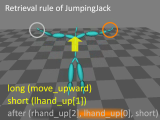

We proposes a method for retrieving human motion data with concise retrieval rules based on the spatio-temporal features of motion appearance. Our method first converts motion clip into a form of clausal language that represents geometrical relations between body parts and their temporal relationship. A retrieval rule is then learned from the set of manually classified examples using inductive logic programming (ILP). ILP automatically discovers the essential rule in the same clausal form with a user-defined hypothesis-testing procedure. All motions are indexed using this clausal language, and the desired clips are retrieved by subsequence matching using the rule. Such rule-based retrieval offers reasonable performance and the rule can be intuitively edited in the same language form.

|
CASA 2009 video QuickTime: 24.0 MB, without Audio 640×480, 3:00 |

|
SCA 2007 video QuickTime: 26.0 MB, without Audio 512×512, 3:05 |